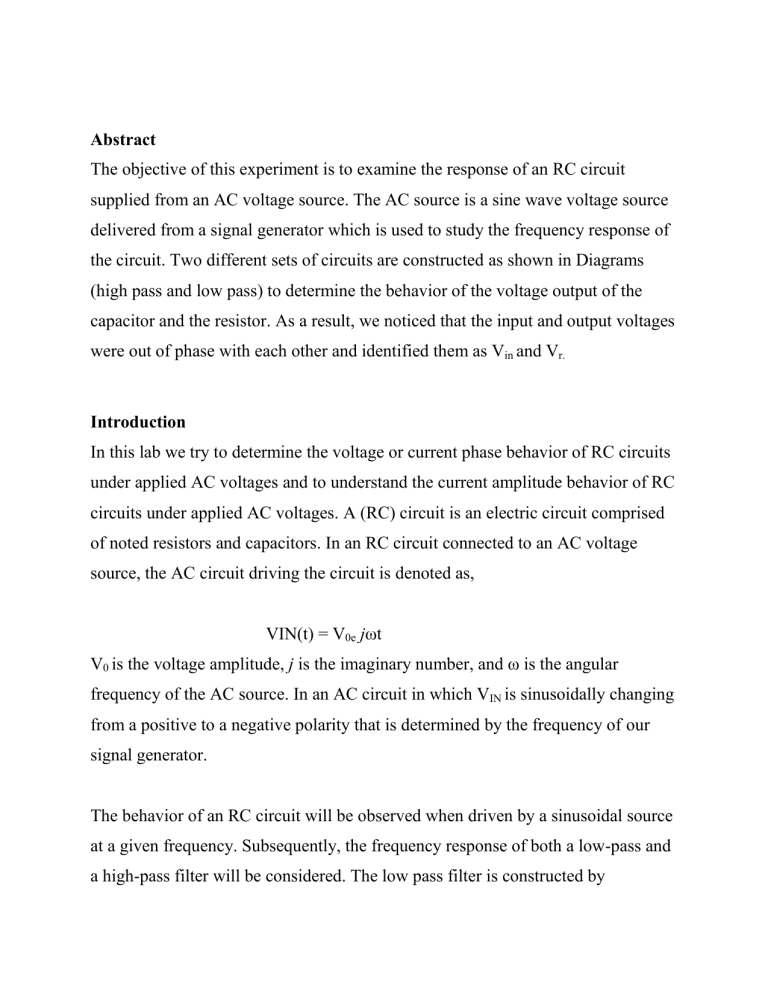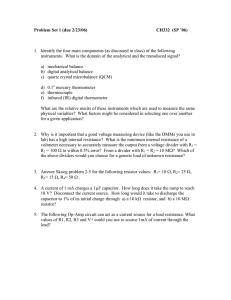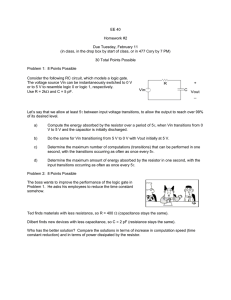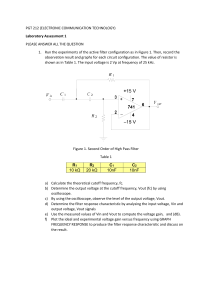
Abstract The objective of this experiment is to examine the response of an RC circuit supplied from an AC voltage source. The AC source is a sine wave voltage source delivered from a signal generator which is used to study the frequency response of the circuit. Two different sets of circuits are constructed as shown in Diagrams (high pass and low pass) to determine the behavior of the voltage output of the capacitor and the resistor. As a result, we noticed that the input and output voltages were out of phase with each other and identified them as Vin and Vr. Introduction In this lab we try to determine the voltage or current phase behavior of RC circuits under applied AC voltages and to understand the current amplitude behavior of RC circuits under applied AC voltages. A (RC) circuit is an electric circuit comprised of noted resistors and capacitors. In an RC circuit connected to an AC voltage source, the AC circuit driving the circuit is denoted as, VIN(t) = V0e jωt V0 is the voltage amplitude, j is the imaginary number, and ω is the angular frequency of the AC source. In an AC circuit in which VIN is sinusoidally changing from a positive to a negative polarity that is determined by the frequency of our signal generator. The behavior of an RC circuit will be observed when driven by a sinusoidal source at a given frequency. Subsequently, the frequency response of both a low-pass and a high-pass filter will be considered. The low pass filter is constructed by connecting in series a resistor and a capacitor where the input signal (VIN) is applied to the series combination and the output signal is taken across the capacitor, and the high pass filter circuit takes the output voltage of the resistor. We place the amplitude of VOUT to the amplitude of the VIN signal in a ratio form for the High pass filter as it written as; |VOUT/VIN | = (1 + (1/ωRC)2)-½ This is known as the gain of the filter (dB0 which is a function of the output value divided by its corresponding input value and is its unit Is in decibels as dB = 20log((1 + (1/ωRC)2)-½ And for the low Pass filter, the ration of the amplitude of VOUT to the amplitude of the VIN signal is given as |VOUT/VIN | = (1 + (ωRC)2)-½ And the gain in decibels (dB) for this is. dB = 20log ((1 + (ωRC)2)-½ The current and voltage do not peal when they are Capacitors are involved in the AC circuit. And the phase difference is the the fractions of period difference between the peaks shown by both. This can be calculated by taking the time difference between VIN and VOUT , dividing it by the period known, and multiply by (2pi). This is denoted as; φ = (Δt/T) x 2π or φ = (2 πf (Δt)) Experiment We start this experiment by constructing a high-pass filter circuit that is attached to an AC voltage source using the given nominal values of 220 Ω resistor and 0.01 μF capacitor. Using the DMM, we measure the actual values of both components along with their uncertainties. The signal generator generates the sinusoidal form of the voltage source (VIN) and obtain a frequency value where (ω << 1/RC). From the oscilloscope, VIN output is displayed, the output of VIN and channel 2 displayed the voltage output across the resistor (VR). From the display observed, the amplitude of both outputs can be determined and the phase of VR. This is used to measure for ten frequencies that are relatively evenly spaced on the scale that cover the range of 0.1 to 10 times the angular frequency. The scaling is measured for (0.1, 0.2, 0.4, 0.8, 1, 2, 4, 8, and 10) times the frequency chosen. The (-3 dB) is measured which occurs when the output signal is attenuated to a percentage of 70.7% of the input signal value or -3dB (20 log (VOUT/VIN)) of the input. This is known as the cutoff frequency denoted as fC = 1/2πRC. And we repeat the same procedure for the subsequent low pass filter circuit whereas for this experiment, the voltage drop across the capacitor is measured. Apparatus *Digital multimeter (DMM) Agilent U1272A. *Oscilloscope Tektronix TDS 10028 *Breadboard *Signal generator (sine wave) (PASCO) *Resistor and capacitor Results We measured value of the resistor acquired is measured as (218.86 ± 0.5) Ω and (0.01 ±0.05)μF. Chosen frequency value is 10 000 Hz. And the values acquired from set experiment are as follows f VIN (V) VR(V) φ (rad) 0.1 5.30 ± 0.1 0.8 ± 0.2 38.96 0.2 5.20± 0.2 1.40 ± 0.4 8.33 0.4 5.00 ± 0.4 3.0 ± 0.2 4.29 0.8 5.20 ± 0.3 5.80 ± 0.2 2.26 1 5.20 ± 0.4 6.80 ± 0.5 1.52 2 5.00 ± 0.3 12.40 ± 0.4 0.703 4 5.20 ± 0.3 23.20 ± 0.2 0.58 8 5.40 ± 0.5 34.40 ± 0.3 0.26 10 5.20 ± 0.3 36.40± 0.4 0.21 At the -3dB point, meaning VR = 0.707(VIN) = 3.741, the frequency at that output value varies the theoretical value of fC, known as fC = 1/(2πRC) =1/(2π x 219Ω x 0.01 μF) = 72.7kHz And the values of low Pass f VIN VC φ (rad) 0.1 5.15 ± 0.4 5.20 ± 0.2 -0 0.2 5.20 ± 0.2 5.2 ± 0.4 -0.30 0.4 5.1 0± 0.5 5.1 ± 0.2 -0.27 0.8 5.20 ± 0.4 5.1 ± 0.3 -0.24 1 5.00 ± 0.3 5.2 ± 0.3 -0.19 2 5.20 ± 0.3 5.00 ± 0.6 -0.18 4 5.00 ± 0.5 4.5 ± 0.4 -0.13 8 5.40 ± 0.6 4.3 ± 0.2 -0.11 10 5.00 ± 0.2 4.2 ± 0.3 -0.07 Discussion The voltage gain magnitude(dB) by logarithmic frequency (in Hz) is a preferred method of examining the character of a filter. For a high pass filter circuit, the output voltage is determined from the resistor, and on observation of the graph, at low frequency, the gain (dB) of the filter is ascending to its cut-off frequency then becomes nearly continuous for higher frequencies. The phase angle ( Φ ) of the output signal leads that of the input and at the cutoff frequency and fC = 72.7kHz Conclusion The low pass filter has a constant output voltage up to a specified cut-off frequency, fC. This cut-off frequency point is 70.7% or -3dB (20log(VOUT/VIN )) of the voltage gain allowed to pass. But based on the results, the output of the gain is descending before the cut-off frequency, and the same is observed for the high pass filter, the gain output is increasing at low frequencies until the frequency reaches the cut-off point. For both cases observed for the high pass and low pass, there is a phase shift between the input voltage and output voltage.





